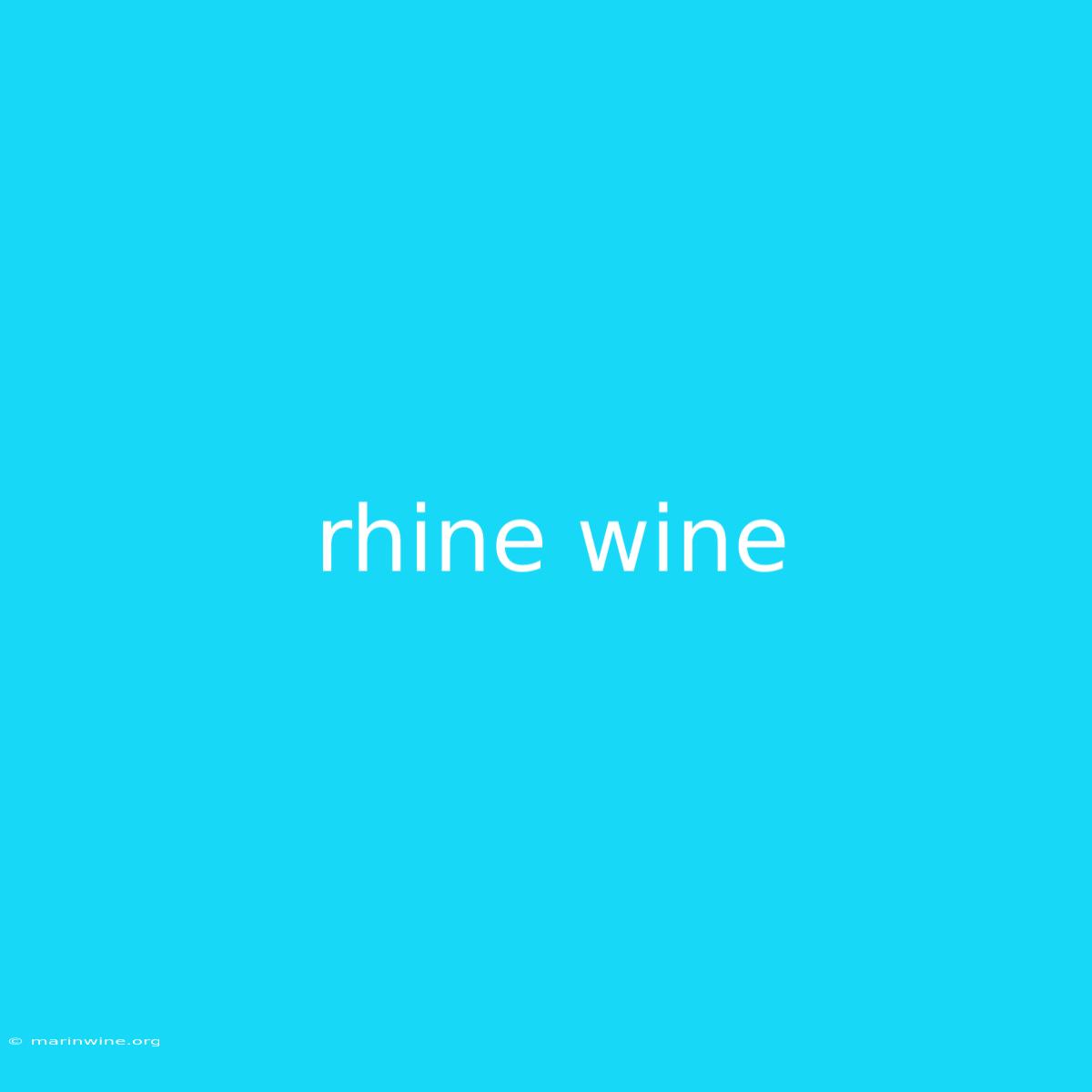Uncorking the Secrets of Rhine Wine: A Journey Through Germany's Iconic Grapes
Have you ever wondered what makes Rhine wine so special? It's more than just a crisp, refreshing drink. It's a testament to centuries of tradition and a symphony of flavors born from the unique landscape of the Rhine Valley.
Why It Matters: The Rhine Valley is a world-renowned wine region, known for its world-class Riesling wines, which are revered for their delicate sweetness, vibrant acidity, and complex aromas.
Key Takeaways of Rhine Wine:
| Aspect | Description |
|---|---|
| Grapes: | Riesling is the dominant grape, producing wines ranging from dry to sweet. |
| Climate: | The Rhine Valley's moderate climate, with its warm days and cool nights, creates ideal conditions for Riesling. |
| Soil: | Slate soils retain heat and give the wines their unique mineral character. |
| Style: | Rhine wines can range from dry, crisp, and refreshing to off-dry and sweet, with a distinct floral and fruity character. |
Rhine Wine: A Symphony of Terroir and Tradition
The heart of Rhine wine lies in the harmonious interplay between terroir and tradition.
Terroir refers to the unique combination of factors that influence the character of a wine, including soil, climate, and geography. The Rhine Valley's slate soils, known for their mineral richness, impart a distinctive, earthy note to the wines. This mineral character, combined with the cool, crisp climate of the region, results in wines with vibrant acidity, excellent aging potential, and a refreshing crispness.
Tradition plays a crucial role in shaping Rhine wine. For centuries, winemakers have adhered to strict regulations, ensuring quality and maintaining the distinctive style of Rhine wines. This commitment to tradition guarantees that each bottle embodies the heritage and history of the region.
Riesling: The Queen of the Rhine
Riesling, the iconic grape of the Rhine, is responsible for the region's reputation for producing exceptional white wines. The versatility of this grape allows for a wide range of styles, from dry and crisp to lusciously sweet, offering something for every palate.
Key Aspects of Riesling:
- Acidity: Riesling possesses high acidity, which brings a refreshing crispness and excellent aging potential.
- Aromas: These wines are known for their complex aromas, including notes of citrus, apple, pear, peach, and floral hints.
- Sweetness: Riesling can range from dry to sweet, with "Spätlese," "Auslese," and "Beerenauslese" denoting progressively sweeter styles produced from grapes harvested later in the season.
- Food Pairing: Rhine Riesling is a versatile wine that pairs well with a wide range of cuisines, including seafood, Asian dishes, and even spicy foods.
Exploring the Connection Between Soil and Flavor
The unique character of Rhine wines is deeply rooted in the slate soils of the region. These soils, composed of decomposed volcanic rock, are rich in minerals and retain heat, influencing the flavor profile of the grapes. The mineral-rich slate imparts a distinctive earthy, salty note, often described as "petrol" or "kerosene," adding a unique complexity to the wines.
Unveiling the Secrets of Rhine Wine: A Detailed Look
Imagine strolling through the picturesque Rhine Valley, where vineyards cling to steep slopes and the air is filled with the scent of grapes. The wines produced in this region reflect the beauty and complexity of their surroundings, capturing the essence of the terroir.
Below is a table showcasing the diverse styles of Rhine wines and their unique characteristics:
| Style | Description | Characteristics |
|---|---|---|
| Dry | Dry Riesling wines are crisp and refreshing with a high acidity. | Citrus, apple, pear, green apple, mineral |
| Off-Dry | These wines offer a delicate sweetness balanced by a vibrant acidity. | Peach, apricot, honeydew melon, floral, mineral |
| Sweet | Sweet Riesling wines, made from grapes harvested late in the season, are rich, complex, and have a long aging potential. | Tropical fruit, honey, spice, botrytis (noble rot) |
The journey of Rhine wine extends far beyond the bottle. Each sip invites you to explore the rich history, diverse flavors, and captivating landscapes of the Rhine Valley.
FAQ for Rhine Wine:
Q: What is the best way to serve Rhine wine?
A: Riesling is best served chilled, between 45°F and 55°F (7°C and 13°C).
Q: How long can Rhine wine be aged?
A: Dry Riesling wines can age for 5-10 years, while sweeter styles can age for much longer, developing complex flavors over time.
Q: What food pairs well with Rhine wine?
A: Dry Riesling pairs well with seafood, salads, Asian dishes, and lighter meats. Off-dry Riesling complements creamy dishes, poultry, and cheeses, while sweet Riesling pairs beautifully with desserts and spicy cuisines.
Q: Are there different regions within the Rhine Valley?
A: Yes, the Rhine Valley is divided into various regions, each with its unique terroir and wine style. Some of the most prominent regions include the Mosel, Rheingau, and Pfalz.
Tips for Exploring Rhine Wine:
- Start with a dry Riesling: To appreciate the full range of flavors, begin with a dry Riesling.
- Explore different regions: Each region has its own distinctive character, offering a diverse range of styles.
- Pair with food: Experiment with different food pairings to discover the best complement for each style of Rhine wine.
- Learn about the history and tradition: Delve into the history of winemaking in the Rhine Valley to deepen your appreciation for these exceptional wines.
Summary of Rhine Wine:
This article has explored the fascinating world of Rhine wine, highlighting its unique terroir, traditional winemaking practices, and diverse styles. From the crisp, refreshing dry Riesling to the lusciously sweet late-harvest wines, Rhine wines offer a symphony of flavors that reflect the beauty and history of the region.
Closing Message: The next time you reach for a glass of white wine, consider venturing into the world of Rhine wine. You'll discover a captivating journey of flavor and tradition, leaving you with a newfound appreciation for the artistry of winemaking in the picturesque Rhine Valley.

